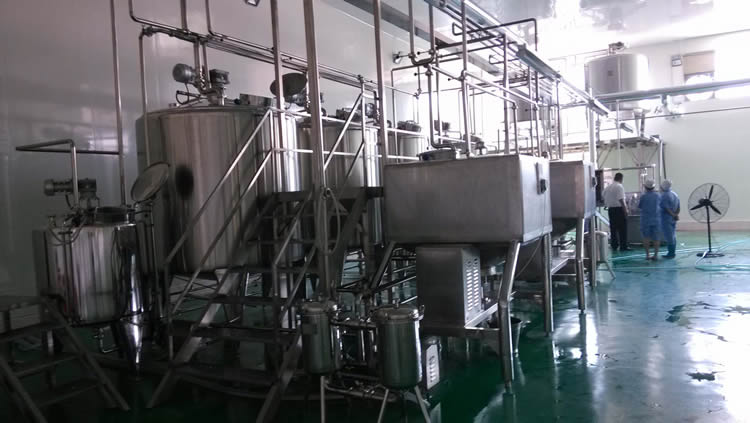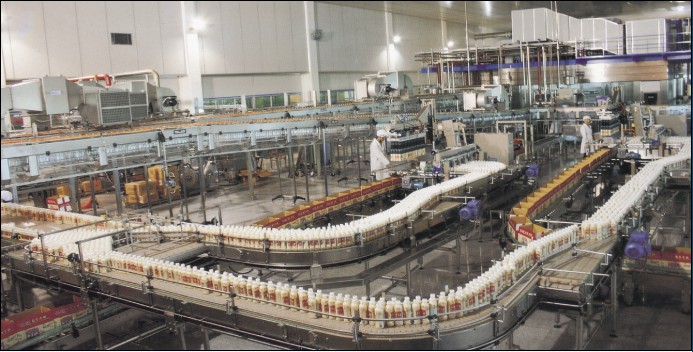

The yogurt production line equipment provided by the company is improved on the basis of fully digesting and absorbing foreign advanced technology. The technology of the yogurt production line equipment is also suitable for the aseptic production and processing of various products in the fields of fruit and vegetable juice, mineral water and pharmaceuticals.
1. Overview of yogurt
Yogurt is a kind of fermented dairy product with high nutritional value and special flavor, which is fermented by lactic acid bacteria with milk as raw material. It is a food with a certain health effect.
Classification of yogurt:
According to the product organization state or production method: coagulated yogurt and stirred yogurt;
According to the fat content of the raw materials: whole yogurt, skimmed yogurt;
According to the type of bacteria: ordinary yogurt, bifidobacterium yogurt, lactobacillus acidophilus yogurt, lactobacillus casei yogurt;
According to product taste: natural pure yogurt, flavored yogurt, sweetened yogurt, etc.;
2. Production process of solidified yogurt
Acceptance and purification of raw milk → standardization → concentration → preheating → homogenization → sterilization → cooling → adding starter → filling → constant temperature cultivation → cooling and post-cooking → finished product
Key points of production process control:
1. Acceptance of raw milk
1) The total dry matter content of fresh milk ≥ 11.5%, and the non-fat dry matter ≥ 8.5%, otherwise it will affect the gelation of protein;
2) No antibiotic residues;
3) Acidity ≤18°T;
4) Do not use mastitis milk.
2. The main raw material for yogurt production
1) Sugar and fruit materials
In the production of yogurt, 5-8% sucrose or glucose is often added;
2) Skim milk powder
Requirements: high quality, no antibiotics and preservatives.
Purpose: To increase the content of dry matter; to improve the state of product organization; to promote acid production by lactic acid bacteria. General addition amount: 1-1.5%
3. Concentration
Purpose: To increase the solid content and promote fermentation coagulation. Method: Concentration under reduced pressure
4. Preheat and homogenize
Preheating purpose: to improve the homogenization effect; 55-60 degrees. Homogenization purpose: to maintain the stability of the mixed solution, homogenization conditions: 15-20MP.
5. Sterilization and cooling
Sterilization is to kill all pathogenic bacteria and most miscellaneous bacteria in raw milk, creating favorable conditions for fermentation. And sterilization can improve the hydration of protein in milk. Cooling temperature after sterilization: 43-45 degrees.
6. Starter and inoculation
Inoculation amount: 1-3%.
Factors affecting the amount of inoculation:
1) Culture temperature and time during fermentation;
2) The acid production capacity of the starter;
3) The cooling rate of the product;
4) The quality of milk.
7. Filling
Filling containers: porcelain jars, glass bottles, plastic bottles, cartons, etc.;
Filling methods: manual filling, semi-automatic filling machine, automatic filling machine, etc.
8. Fermentation: fermentation tank
Cultivation temperature: Determined by the used strain and ratio.
Cultivation time: short-term culture: 41-42 degrees, 3 hours, long-term culture: 30-37 degrees, 8-10 hours. Influencing factors: the amount of inoculum; the activity of the starter; the culture temperature.
9, cooling
Conditions: 3-5 degrees. 5 degrees is the lower limit for mold and yeast growth
Purpose: 1) Inhibit the growth of lactic acid bacteria, reduce enzyme activity, and prevent excessive acid production;
2) Reduce the speed of fat floating and whey precipitation, and extend the shelf life;
3) Promote the production of aroma substances
10. Refrigeration and post-cooking
Conditions: 2-7 degrees, 12-24 hours;
3. Production technology of stirred yogurt
Acceptance and purification of raw milk → standardization → concentration → preheating → homogenization → sterilization → cooling → adding starter → constant temperature cultivation → cooling and stirring (adding fruits, spices, etc.) → filling → refrigeration, post-cooking → finished product
Key points of process management and operation:
1. Stirring:
Purpose: To break the gel and change the hardness and organization of yogurt
Note:

1) Speed control: first low speed and then fast
2) Yogurt temperature: 0-7 degrees is best, production practice is generally below 10-15 degrees;
3) pH of yogurt: <4.7
4) The dry matter content of yogurt: the effect of a moderate increase on the quality of yogurt:
2. Mixing and filling
Sterilization of fruit material: inhibit bacterial growth and maintain the flavor and texture of fruit material.
4. Main equipment for yogurt production
1. Homogenization mechanical equipment: Homogenization is to pulverize larger fat globule particles into countless fat globule particles close to the size of liquid molecules, and disperse them uniformly in the emulsion to obtain coupling between particles and molecules Force to prevent separation of the mixed liquid.
Homogenization purpose:
(1) Slow down fat separation
(2) Obtain a stable and uniform liquid mixture
(3) Facilitate digestion and absorption
At present, homogenization is mainly carried out by using a homogenizer. Commonly used high-pressure homogenizers, colloid mills, jet homogenizers, centrifugal homogenizers, ultrasonic homogenizers, sterilization and cooling machinery and equipment.
2. Sterilization equipment
The key component of the plate type sterilization equipment is the plate heat exchanger, and the plate heat exchanger is composed of many stamped and formed metal sheets. In the production of dairy products, fruit juice drinks, soft drinks, beer, and ice cream, high temperature short time (HTST) and ultra high temperature instantaneous sterilization (UHT) are widely used, and they can also be used for cooling.
3. Fermentation equipment
The yogurt fermentation tank is cylindrical, and the bottom cover and the top cover are both dish-shaped or cone-shaped. The top of the tank is equipped with manholes, sight glasses, feed pipes, inoculation pipes, pressure gauges and measuring instrument interface pipes. The bottom of the tank is equipped with a discharge port. The lower part of the tank body is equipped with a sampling port and a thermometer interface. For large-scale fermentation tanks, in order to facilitate maintenance and cleaning, manholes are often installed near the bottom of the tank.
The yogurt production line mainly includes various flavors of sterilized fresh milk, pasteurized milk, reduced milk, peanut milk, school milk and other equipment for homogenization, cooling, fermentation, stirring, and storage. Our company specializes in the design and production of blended yogurt production lines, peanut milk production lines, and milk production lines. The yogurt production equipment produced by our company is of reliable quality, timely delivery, perfect after-sales, and trustworthy. Welcome yogurt production enterprises from all walks of life, Zhejiang Jinben Machinery Manufacturing Co., Ltd. 18072010088 www.jbmach.com






